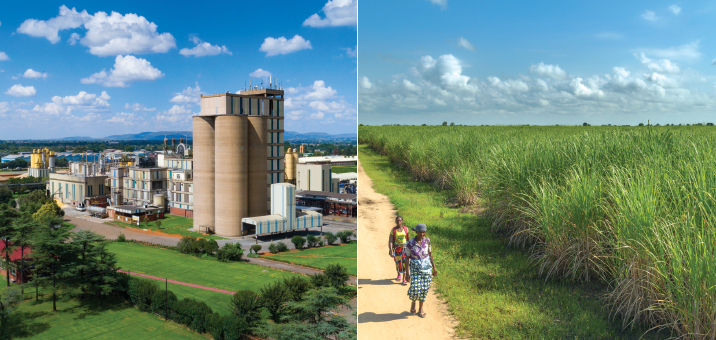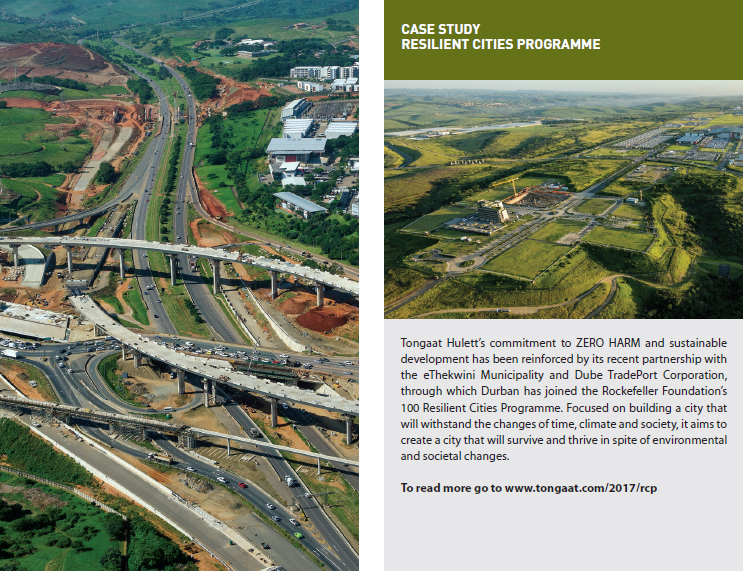TONGAAT HULETT PROFILE



Tongaat Hulett is an agriculture and agri-processing business, focusing on the complementary feedstocks of sugarcane and maize. Its ongoing activities in agriculture have resulted in the company having a substantial land portfolio within the primary growth corridors of KwaZulu-Natal with strong policy support for conversion at the appropriate time. A core element of Tongaat Hulett’s strategic vision is to maximise the value generated from the conversion of land in the portfolio by responding to key demand drivers and identifying its optimal end use for all stakeholders. Through its sugar and starch operations, Tongaat Hulett produces a range of refined carbohydrate products from sugarcane and maize, with a number of products being interchangeable. Global sweetener markets continue to be dynamic and the business seeks to optimise its various market positions, leveraging off its current base to maximise revenue from these products. The business’s sugar operations are well placed to benefit from evolving dynamics of renewable electricity and ethanol in South Africa, and the SADC region. Value creation for all stakeholders through an all-inclusive approach to growth and development is a key focus area for the business and Tongaat Hulett regards its constructive interfaces with governments and society to be of significant importance.
The current structure of the company arose from the merger of the Tongaat Group Limited and the Huletts Corporation Limited, and its operations date back to the mid-1800s. The company has a primary listing on the Johannesburg Stock Exchange dating back to 1952, and a secondary listing on the London Stock Exchange since 1939.
Societal dynamics are increasingly relevant, and therefore the strong relationships that Tongaat Hulett has developed with various stakeholders are of significant importance. These partnering relationships continue to contribute towards the achievement of the business’s strategic objectives, while also meeting the objectives of its various stakeholders, including shareholders, governments, private farmers and their representative bodies, communities, employees and people impacted by the company’s operations and its growth and development activities.
SUGAR OPERATIONS
SOUTH AFRICA
The company’s South African sugar operations on the KwaZulu-Natal north coast and in the Zululand region operate four sugar mills at Maidstone, Darnall, Amatikulu and Felixton. These mills have an installed capacity to produce more than 1 million tons of sugar per annum. Cane supplies come from a combination of predominately rain-fed own-estates, large-scale commercial and small-scale private farmers in rural KwaZulu-Natal. At the beginning of the 2016/17 season, the South African operations were supplied by 122 856 hectares. The operation’s central refinery in Durban produces some 600 000 tons of high-quality refined sugar per annum, with the primary product being the leading Huletts® brand. The South African sugar product range offers a total sweetener solution including a range of high-intensity sweeteners.
ZIMBABWE
The sugar operations in Zimbabwe consist of Triangle and a 50,3% stake in Hippo Valley Estates, representing a combined installed sugar milling capacity of more than 640 000 tons.
At the beginning of the 2016/17 season, the Zimbabwe operations were supplied by 45 339 hectares of sugarcane land (own-estates and private farmers) with a potential to produce more than four million tons of sugarcane. The total refined sugar installed capacity is 140 000 tons and the Triangle ethanol plant has an installed capacity of 42 million litres over a 48-week production season. The securing of adequate water availability is important, and the completion of the Tokwe-Mukorsi dam (1,803 million megalitre capacity), in addition to the existing 1,740 million megalitres of the Mutirikwi dam, significantly improves water security of the operation.
The Huletts Sunsweet® brand is the leading sugar brand in the country. The Lowveld in Zimbabwe, with excellent topography, climate and established water storage and conveyance infrastructure for irrigation, is recognised globally as a highly competitive sugar producer. The Zimbabwean operations include the business running the largest cattle herd and extensive game reserves, which have significant potential for tourism.
MOZAMBIQUE
The Mozambique sugar operations comprise the expanded sugar mills and estates surrounding Xinavane and Mafambisse. At the beginning of the 2016/17 season, 29 120 hectares supplied Tongaat Hulett operated mills. Sugar production capacity at the Xinavane mill is more than 250 000 tons in a 32-week crushing season, while the Mafambisse mill has an existing 90 000 tons of sugar production capacity. The two operations have a combined installed milling capacity in excess of 340 000 tons of sugar per annum. The sugar estates are irrigated and are generally located in areas with favourable growing conditions, resulting in high cane and sucrose yields. The larger Xinavane operation will benefit from the construction of the Moamba dam (760 000 megalitre capacity) and the extension of the Corumana dam wall which will result in its capacity being increased from 880 000 megalitres to 1,260 million megalitres by May 2019.
The favourable agricultural conditions, proximity to ports, and the technical support from South Africa, position the Mozambique operations well for further growth. The operations also include extensive landholdings, which border the Kruger National Park, and have high tourism potential.

SWAZILAND
Tongaat Hulett’s Tambankulu sugarcane estate in Swaziland is situated in the north east of the country and comprises 3 838 hectares of fully-irrigated farms of which approximately 3 740 hectares are harvested annually. The estate has consistently achieved excellent sucrose yields due to the good soil and growing conditions in the region and delivers its cane to the nearby Simunye and Mhlume sugar mills. The estate has the capacity to produce a Raw Sugar Equivalent (RSE) of some 60 000 tons per annum.
NAMIBIA AND BOTSWANA
The Namibian operation has the capacity to pack and distribute 80 000 tons of sugar per annum using its Marathon® brand while in Botswana, Tongaat Hulett has a 60 000 ton per annum packing and distribution operation with its leading Blue Crystal® brand.
RENEWABLE ENERGY
The eight sugar mills in Mozambique, South Africa and Zimbabwe all generate electricity from bagasse during the sugarcane crushing season. In some instances, these operations supply electricity to the grid. In Zimbabwe, Triangle has an ethanol plant which provided 21,4 million litres for blending with petrol during the 2016/17 year. Tongaat Hulett is well placed to benefit from evolving renewable energy dynamics with the potential to build large-scale renewable electricity plants, as well as the opportunity to convert its export sugar to ethanol in its southern African operations.
VOERMOL FEEDS
The company’s animal feeds operation, Voermol Feeds, is located at the Maidstone mill in Tongaat, KwaZulu-Natal. Tongaat Hulett manufactures and markets a range of energy and supplementary feeds to the livestock farming community through its Voermol® brand, using bagasse and molasses. The production and marketing of high-quality, cost-effective products over more than 50 years, combined with the development of long-term relationships with farmers, agricultural companies and suppliers, has established Voermol Feeds as the market leader in the molasses and pith-based animal feeds industry in South Africa.

STARCH AND GLUCOSE OPERATION
Tongaat Hulett’s wet-milling operation is the major producer of starch and glucose on the African continent. Established in 1919, the starch operation is an important supplier to a diverse range of South African and African industries. Operating four wet-milling plants located in Kliprivier, Germiston and Meyerton in Gauteng and Bellville in the Western Cape, Tongaat Hulett converts more than 630 000 tons of bought-in maize per annum into starch and starch-based products. The business manufactures a wide range of products, from unmodified maize starch to highly-refined glucose products, which are key ingredients for manufacturers of foodstuffs, beverages and a variety of industrial products. The company’s Amryal® corn starch, Hydex® and Vaalgold® Gluten 60 remain some of the leading starch, glucose and feed ingredient brands in South Africa. The co-products that are produced during the starch and glucose manufacturing process supply the animal feed industry. The business operates a dedicated Sorbitol facility, which is in Chloorkop in Gauteng, and has distribution networks and facilities in Zimbabwe, Australasia and the Far East.
The world is continuing to evolve in terms of the selection of a feedstock to produce sweeteners, with both maize and sugarcane being suitable alternatives. Tongaat Hulett’s significant investments in the production of sweeteners using both feedstocks will ensure that the business is well positioned to benefit from global developments in this area.
LAND CONVERSION ACTIVITIES
Tongaat Hulett has an unequalled portfolio of some 7 709 developable hectares of land in prime positions near Durban and on the north coast of KwaZulu-Natal earmarked for conversion from agriculture to a range of urban and tourism uses over time. The company’s sugar mills in South Africa are supplied by more than 120 000 hectares of sugarcane land, of which some 34% is farmed by communal or small-scale farmers and land reform growers, and just over 7% is owned by Tongaat Hulett. The business is focused on creating stakeholder value through converting land within its portfolio of prime land near Durban and Ballito to enable investors, developers, end-users and authorities to access bankable shovel-ready real estate investment projects that yield the best possible urban use.
Durban is one of the fastest growing cities and as part of its endevours to improve its sustainability the city has joined the Rockefeller Foundation’s 100 Resilient Cities Programme. Tongaat Hulett has partnered with the city on this initiative which aims to improve the city’s resilience and long-term sustainability.
These activities are underpinned by ongoing use of the land under agriculture throughout the development cycle and commence with collaborative planning with authorities on optimum use of land for all stakeholders. This leads to the release from agriculture and other development approvals, simultaneously strengthening demand drivers and unlocking infrastructure at key points, while executing optimal sales and development strategies for the various parcels of land.
Further details regarding these ongoing processes are provided in Tongaat Hulett’s Portfolio of Land for Conversion in KwaZulu-Natal, available here.






